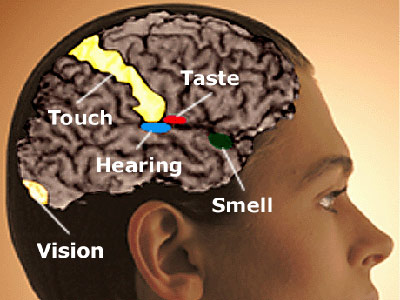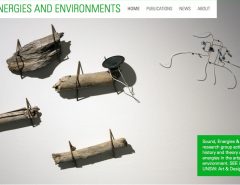http://www.sensequence.de/proj/projen.html
Synesthesia (Wikipedia):
Synesthesia (also spelled synæsthesia or synaesthesia, plural synesthesiae)—from the Greek syn- meaning union and aesthesis meaning sensation—is a neurological condition in which two or more bodily senses are coupled. In one common form of synesthesia, known as grapheme ? color synesthesia, letters or numbers are perceived as inherently colored, while in ordinal linguistic personification, numbers, days of the week and months of the year evoke personalities. In spatial-sequence, or number form synesthesia, numbers, months of the year, and/or days of the week elicit precise locations in space (for example, 1980 may be «farther away» than 1990), or may have a three-dimensional view of a year as a map (clockwise or counterclockwise).
While cross-sensory metaphors are sometimes described as «synesthetic», true neurological synesthesia is involuntary and occurs in slightly more than four percent of the population (1 in 23 persons) across its range of variants (Simner et al. in press). It runs strongly in families, possibly inherited as an X-linked dominant trait. Synesthesia is also sometimes reported by individuals under the influence of psychedelic drugs, after a stroke, or as a consequence of blindness or deafness. Synesthesia that arises from such non-genetic events is referred to as adventitious synesthesia to distinguish it from the more common congenital forms of synesthesia. Adventitious synesthesia involving drugs or stroke (but not blindness or deafness) apparently only involves sensory linkings such as sound ? vision or touch ? hearing; there are few if any reported cases involving culture-based, learned sets such as graphemes, lexemes, days of the week, or months of the year.
Although synesthesia was the topic of intensive scientific investigation in the late 1800s and early 1900s, it was largely abandoned in the mid-20th century, and has only recently been rediscovered by modern researchers. Psychological research has demonstrated that synesthetic experiences can have measurable behavioral consequences, while functional neuroimaging studies have identified differences in patterns of brain activation (for a review see Hubbard & Ramachandran 2005).
Many people with synesthesia use their experiences to aid in their creative process, and many non-synesthetes have attempted to create works of art that may capture what it is like to experience synesthesia. Psychologists and neuroscientists study synesthesia not only for its inherent interest, but also for the insights it may give into cognitive and perceptual processes that occur in everyone, synesthete and non-synesthete alike.





I have synestetigia and its awesome !!!!!!
do what is RIGHT, in the right process. be in tune with subtle understanding. emotions are like water that runs in between situations. it is feeling the whole universe around you as part of you as being connected in abstract ways, what some may call art, design but basically it is about how you see things. it is sensing time in the future, past, present happening all at once, you can control the way you want, in the way you wish it aligned to be.
takes a genius to understand that